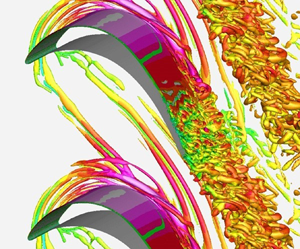Article contents
Transition-based constrained large-eddy simulation method with application to an ultrahigh-lift low-pressure turbine cascade flow
Published online by Cambridge University Press: 27 April 2022
Abstract

A transition-predictive Reynolds-averaged Navier–Stokes (RANS) model is introduced as the Reynolds controlling condition to constrained large-eddy simulation (TrCLES) to improve the ability of this method to predict wall-bounded laminar–turbulent transition flows. In the TrCLES method, the constraint conditions for total Reynolds stress and heat flux are only imposed to the near-wall region in transitional and turbulent boundary layer. The newly proposed method recovers direct numerical simulation in the laminar boundary region, and retrieves the traditional large-eddy simulation method in the far-wall regions. The TrCLES method is validated in simulations of external flow around the Eppler 387 (E387) airfoil and internal flow past the ultrahigh-lift low-pressure turbine T106C cascade. The improved delayed detached-eddy simulation (IDDES) method, CLES method based on full-turbulence shear stress transport model and RANS method with a three-equation transition model are also evaluated in comparison with the available experimental and numerical data. As expected, the TrCLES method can predict laminar separation bubble and separation-induced transition process in both the E387 and T106C flows pretty well. In contrast, neither IDDES nor the original CLES can provide reasonable prediction for the laminar separation-induced transition phenomenon. The validity and fidelity of the TrCLES method are further verified by simulations of the T106C cascade flows in a wider range of exit Reynolds and Mach numbers. It is shown that the TrCLES method can not only predict the time-averaged aerodynamic quantities such as isentropic Mach number and exit kinetic energy loss very well, but also capture the laminar separation bubble and unsteady flow structures with satisfactory accuracy.
- Type
- JFM Papers
- Information
- Copyright
- © The Author(s), 2022. Published by Cambridge University Press
References
REFERENCES
- 10
- Cited by



